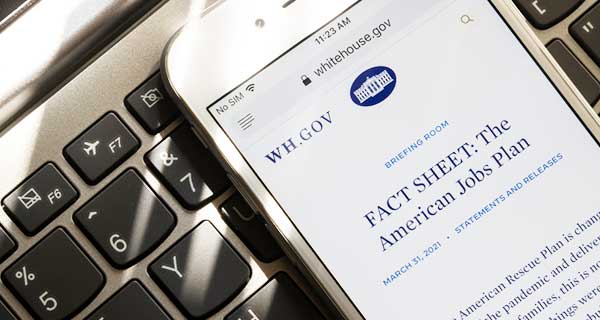
An OH&S Impact Guide to The American Jobs Plan
If passed, even a portion of the projects outlined in President Biden’s plan has serious implications for worker occupational, health, safety, and well-being.
- By Jyoti Kumar
- Jun 21, 2021
At the end of March, President Biden unveiled his $2 trillion infrastructure plan, The American Jobs Plan, which called for large-scale investments in manufacturing, research, worker training, and protection systems, among other priority spending proposals to rebuild and revitalize American infrastructure. Specifically, the administration called for $300 billion in the plan to be invested in manufacturing, including support for domestic production of technologies and critical goods; $50 billion toward semiconductor manufacturing and research; $180 billion on new research and development with an emphasis on clean energy, fewer emissions, and climate change research and $100 billion for worker training and an increase of worker protection systems.
However, with these priority investments also comes a new set of challenges for the occupational health and safety industry. Under the Biden administration, there is likely to be heightened regulatory scrutiny as more federal inspectors will likely lead to an increase in inspections and ultimately increased scrutiny from local agencies. Furthermore, ongoing issues of data security within the supply chain are only going to increase as the projects require more data and materials, ultimately making them appealing targets for cyber attacks and continued shortages of construction materials.
Paramount among all these challenges remains employee wellness and total worker health. The demand for employees under this plan will only grow, possibly leading to the over-extension of the available and quality workforce. While the plan is expected to generate jobs for millions of US workers if passed, companies in sectors like construction, engineering, automotive manufacturers, semiconductor makers, renewable energy producers, home builders, and fiber-optic companies are expected to benefit from job growth, but their health and safety must also be prioritized and protected.
If passed, even a portion of the projects outlined in President Biden’s plan has serious implications for worker occupational, health, safety, and well-being, which is why it is critical that OH&S professionals prepare for and mitigate the possible impacts of these new projects to protect workers.
For example, construction workers, one of the most dangerous jobs in the country, face hazards daily on the job associated with outdoor work such as heat or cold, exposure to vapors/gas/dust/fumes, and even skin contact with chemical substances. Therefore, tracking and managing physical and mental health exposures and impacts of this workforce will continue to be a challenge. However, by implementing robust OH&S programs with increased awareness and training on these issues, there is a great opportunity to further protect these workers and the new ones that will be entering into this workforce as a result of demand.
Furthermore, as a result of the COVID-19 pandemic, companies across all industries, and particularly within the construction industry, are seeking assistance and resources on mental health. Going forward, expect to see construction industry OH&S professionals continue to prioritize mental health and well-being strategies, programs, and initiatives with an increased sense of responsibility and consider the total health of their workers as a part of their overall health and safety program.
So, whether you are making changes to your OH&S total worker health programs as a result of the pandemic or in preparation for the possible passage of the American Jobs Plan, there are three key steps OH&S industry leaders can undertake now to prepare and prioritize worker health:
- First, evaluate your existing industrial hygiene program. This can include reviewing exposure data for known hazards such as silica, lead, metal fumes, etc., to determine where improvements can be made based on expected exposure scenarios and evaluate current data and work scenarios to improve predictions for future exposures. It can also include conducting a Gap assessment of all OH&S programs to assess worker well-being.
- Second, evaluate new respiratory hazards such as engineered nanomaterials in construction materials. There are a number of industry resources from The Center for Construction Research and Training (CPWR) and NIOSH that can help identify and predict inhalation and dermal exposures and provide mitigation strategies for exposure to hazardous materials.
- Third, integrate well-being into traditional OH&S and industrial hygiene programs. Resources such as the Worker Well-Being Questionnaire from NIOSH and standards such as ISO 45001 Occupational Health and Safety Management System and ISO 45003 Occupational Health And Safety Management — Psychological Health And Safety At Work — Guidelines For Managing Psychosocial Risks, can help businesses move beyond employee behaviors to examine the organizational factors that also contribute to total worker health.
Ultimately, to eliminate worker risks and ensure resilience, it is necessary that organizations implement and maintain compliant health and safety programs, and it is my hope that requirements and performance metrics for robust occupational health and safety, industrial hygiene, and well-being programs will be key criteria for contracts awarded as part of the infrastructure bill. However, it is important to remember that similar to the proposed infrastructure investments in the American Jobs Plan, OH&S programs can reach far beyond just the individual worker and help contribute to healthier communities overall.